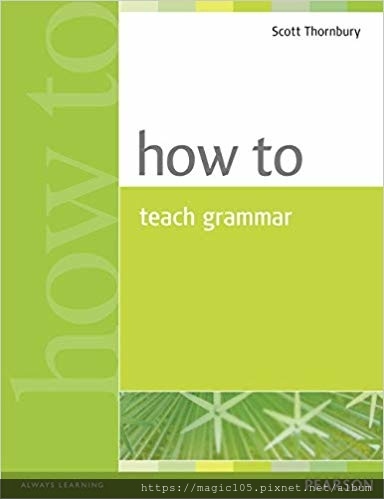For the spring semester, I took a course called "How to teach Linguistic and Grammar". We have the main course book and teacher offered some others as references as well. "How to teach Grammar" is one of them.

![]() author : Scott Thornbury
author : Scott Thornbury
He is currently Curriculum Coordinator of the MA TESOL program at The New School in New York. Also, he is an associate of the International Teacher Development Institute (iTDi), an online campus dedicated to teacher development.
photo credit : amazon
![]() Note of How to Teach Grammar
Note of How to Teach Grammar
chapter 3
"How to teach Grammar" Note
Chapter 3 How to teach Grammar from Rules
A deductive approach Rules and explanations
- A deductive approach starts with the presentation of a rule and is followed by examples which the rule is applied. ( rule driven learning )
Grammar translation:
Grammar translations lesson started with an explanation (usually in the learner's mother tongue) of a grammar point. Practice activities followed which involved translating sentences out of and into the target language.
Strength: time saving, it respects the intelligence and maturity of many - especially adult students
Weakness: little practice of the target language because teacher used students’ mother tongue. Also, Grammar-Translation is not viable in multilingual classes.
this approach does require is teachers with sufficient proficiency in both languages - the learners' mother tongue and the target language - to make it work.
They may not have sufficient metalanguage (i.e. language used to talk about language such as grammar terminology).
Language is simply a case of knowing the rules.
Explanation is seldom as memorable as other forms of presentation
- An inductive approach starts with some examples from which a rule is inferred. (Discovery learning respectively.)
J Michael Swan offered criteria
Truth: Rules should be true. While truthfulness may need to be compromised in the interests of clarity and simplicity, the "rule must bear some resemblance to the reality it is describing.
Limitation: Rules should show clearly what the limits are on the use of a given form. For example, to say simply that we use will to talk about the future is of little use to the learner since it doesn't show how will is different from other ways of talking about the future (e.g. going to),
Clarity: Rules should be clear. Lack of clarity is often caused by ambiguity or obscure terminology. For example: 'Use will for spontaneous decisions; use going to for premeditated decisions.' To which a student responded, 'All my decisions are premeditated'.
Simplicity: Rules should be simple. Lack of simplicity is caused by overburdening the rule with sub-categories and sub-sub-categories in order to cover all possible instances and account for all possible exceptions. There is a limit to the amount of exceptions a learner can remember.
Familiarity: An explanation should try to make use of concepts already familiar to the learner. Few learners have specialized knowledge of grammar, although they may well be familiar with some basil.' terminology med to describe the grammar of their own language (e,g, conditional, infinitive, gerund). Most learners have a concept of tense (past, present, future), but will be less at home with concepts such as deontic and epistemic modality)" for example.
Relevance: A rule should answer only those questions that the student needs answered, These questions may vary according to the mother tongue of the learner. For example, Arabic speakers, who do not have an equivalent to the present perfect, may need a different treatment of this form them, say, French speakers, who have a similar structure to the English present perfect, but who use it slightly differently.
Sample lesson 1: Using a rule explanation to teach question formation
Sample lesson 2: Teaching used to using translation
Sample lesson 3: Teaching articles using grammar worksheets
Sample lesson 4: Teaching word order using a self-study grammar





 留言列表
留言列表